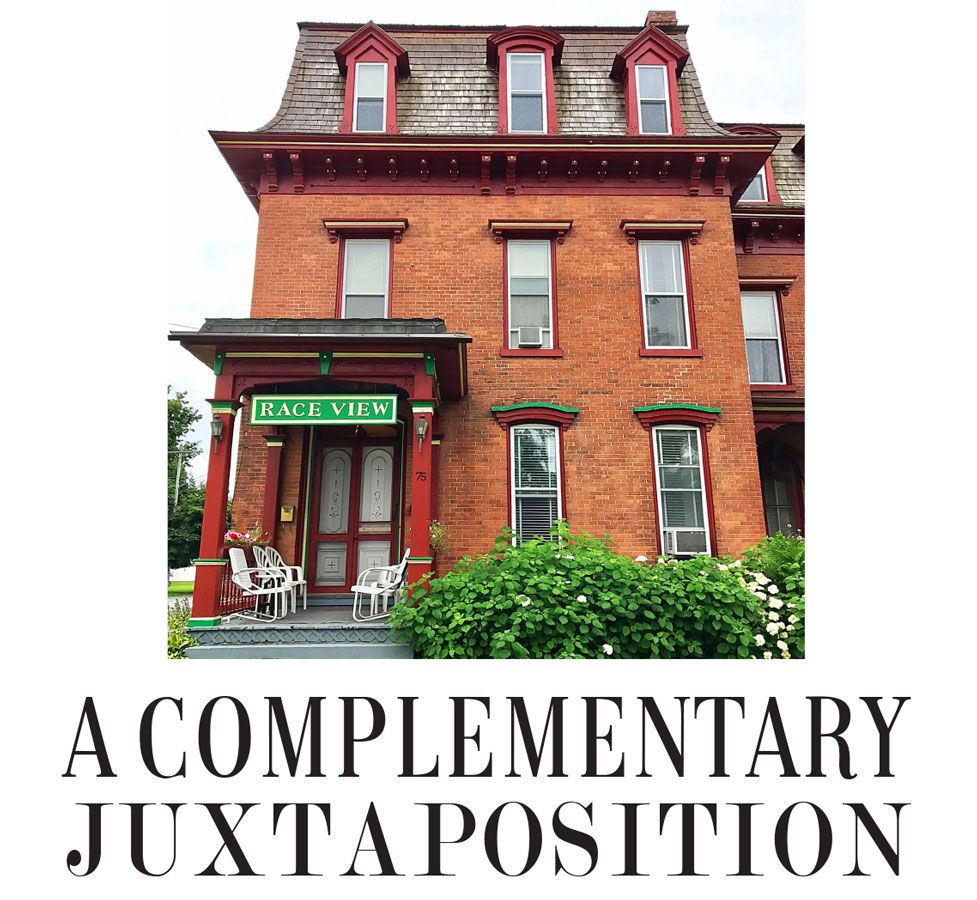
Written by Bill Orzell
The special arrangement in which things are placed and the way they are drawn together, along with the spontaneous and natural liking of this relationship, may explain some of the affinity many have for the Saratoga Race Course. One long time presence, in desirable contiguity to the race course is the mansard capped brick structure on Nelson Avenue at Crescent Street known as Race View. The propinquity between building and track extends far back in time, although neither occupies their original location.
The race course laid out by John Morrissey and his partners in the Saratoga Association in 1864 needed to fit the property they had recently acquired on the south side of Union Avenue, after demonstrating the success of their venture across the street the year before. The track was a one mile circuit, yet many horsemen felt it fell short of that published distance. The racing plant bordered against what would become the Trask estate of Yaddo on Union Avenue and the Gridley Farm, and several smaller properties on Nelson Avenue. Robert Gridley operated stocked trout ponds in the picturesque dell, which during the winter furnished ice for domestic purposes, and Gridley Avenue extended to the east across Yaddo.
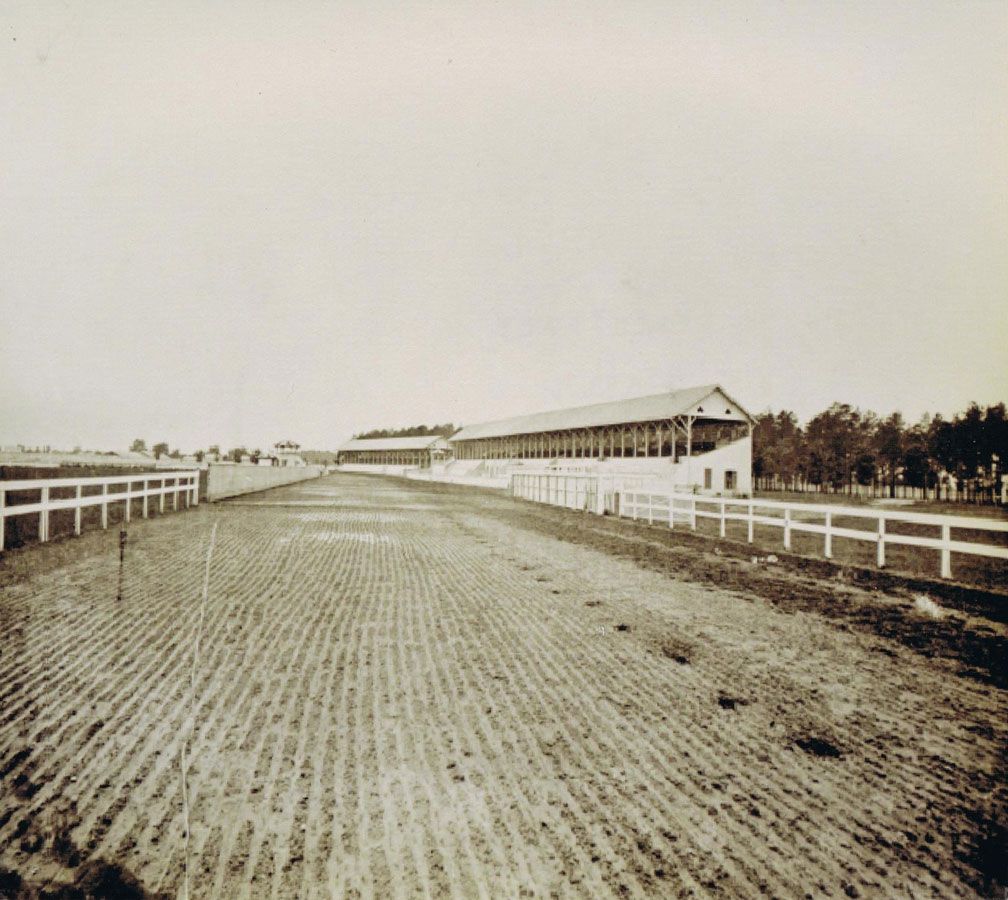
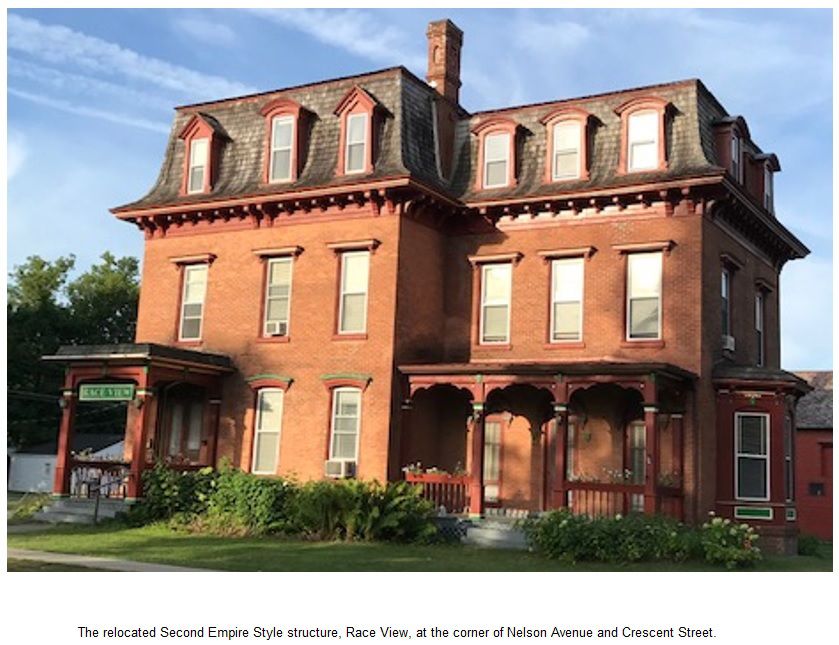
Also on the east side of Nelson Avenue, and north of the road leading to the Gridley ponds, Levi S. Noyes improved his nine acres with an attractive masonry three-story residence. The Noyes House was of the Second Empire Style with its ubiquitous mansard roof and heavy ornamentation, veranda and bay window. These elements made the dwelling very noticeable, and a waymark in directions to the ponds or race venue. Newspaper accounts in 1869 describe Noyes and his family in residence, stabling race horses in their barn.
Global financial instability occurred in the early 1870s and the property changed hands several times, coming into possession of the Fuller family in 1876. Isaiah Fuller was for many years warden of the State prison at Dannemora, and the building was his summer home.
By 1890 all of the original investors in the Saratoga Race Course had passed away, and the track was operated by a single shareholder, Albert Spencer, rendering the Saratoga Association an association in name only. Mr. Spencer was an avid art collector, with a strong desire to retire and travel, and rumors abounded about a change in ownership. A much anticipated deal, with a consortium of noted racing men of unlimited capital, fell through. Mr. Spencer accepted a subsequent deal brokered in August 1891 by Paul Grening, originally from Germany and the proprietor of the Kensington Hotel on Union Avenue, which installed fellow émigré Gottfried Gottlieb Walbaum as owner. Many shuddered to learn the disreputable “Dutch Fred” Walbaum had taken over Saratoga, as his operations at the Guttenberg Race Track near Weehawken, New Jersey were notorious.
The new owner moved quickly in planning improvements. In November 1891 he contracted with Boston architect H. Langford Warren for a new clubhouse and grandstand complex. Warren’s design included elements similar to the South End Grounds baseball pavilion in Boston, and made the Saratoga track an easily recognizable landmark for generations, into our time.
However, G.G. Walbaum’s operations kept many horsemen away. Traditional stakes events were not run, and his discomfiting operations seriously imperiled many financial interests at the Spa. It took the sagacity of Richard T. Wilson to form a syndicate of interested sportsmen, including the politically astute William C. Whitney as President, to buy out Walbaum’s interests in late 1900 and oust his misguided management.
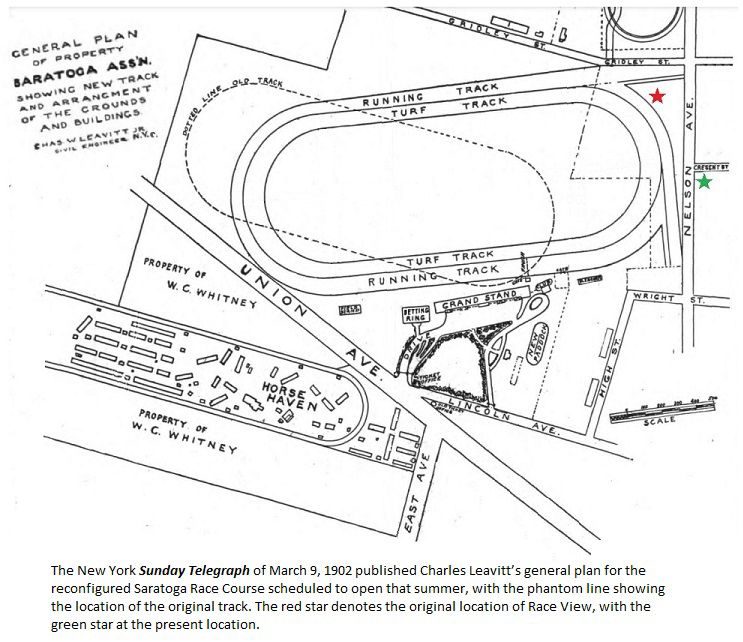
The Whitney and Wilson-led Saratoga Association began their operation of the track in 1901, with the majority of this collective also involved with the operation of the Sheepshead Bay track in Brooklyn. During the winter of 1901, extensive changes were made at Saratoga by track designer Charles Leavitt, increasing the size of the oval and repositioning its orientation on the grounds. The increase from eight furlongs, or one mile, to nine furlongs mirrored the track in Brooklyn and required more property. The reconfigured track included two chutes (straightaways tangent to the oval) for starting races. The one-mile chute allowed for a start into the clubhouse turn, and the seven-furlong chute truncated the eastern extension of Gridley Street. The racecourse redesign required moving all the buildings on the property, relocating the clubhouse, grandstand and betting ring to the reoriented trackside. To accomplish the rearrangements, the grandstand was separated into three sections and reset as separate units, with the areas between becoming major additions which increased the overall length of the structure. Contractor Pennell & Oliver of Yonkers began building the new track in October. The contract for moving all the structures to new locations was extended to Saratoga Springs resident Miles Bradley, who specialized in rigging work and relocating houses.
In 1901 William C. Whitney ambitiously purchased real estate bordering the race course, acquiring land across Union Avenue to build the Oklahoma Training Track, and property to the east from Spencer Trask for expanding the Horse Haven stables. Closing Gridley Street east of Nelson Avenue was an important lever in the negotiations with Mr. Trask, removing an undesirable rear entrance to Yaddo. Additionally, Mr. Whitney purchased the Isaiah Fuller house on Nelson Avenue, which then stood in the space between the reconfigured clubhouse turn and the new seven-furlong chute. Conjecture took place as to how Mr. Whitney, a recent widower, would use the house built by Levi Noyes. At Sheepshead Bay, Mr. Whitney bought Garretson's Mill and furnished the historic building and grounds as a racing lodge, with the same use expected at the Spa. William Whitney hired Saratoga resident Joseph Morrissey to act as his agent when he was away. In 1902 Mr. Whitney purchased several large tracts on the west side of Nelson Avenue (portions of these properties are the present harness raceway), and the trusted Joseph Morrissey would manage what was known as the Whitney Farm.
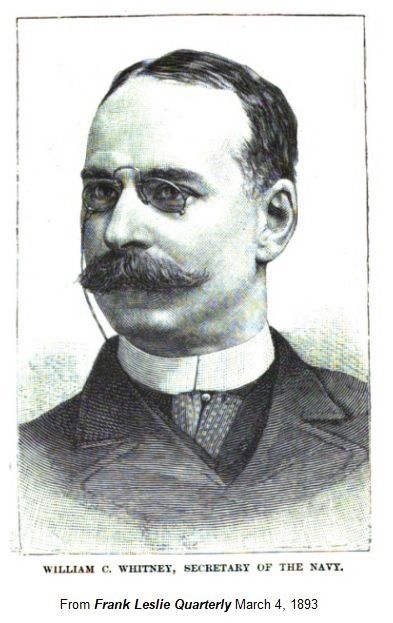
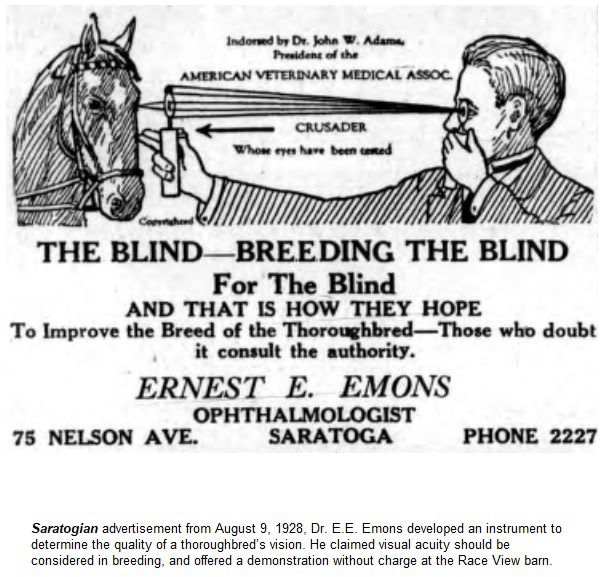
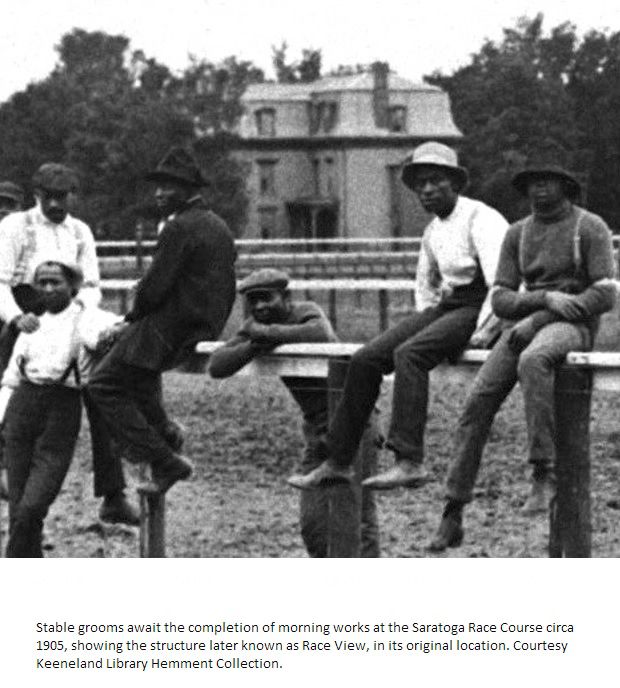
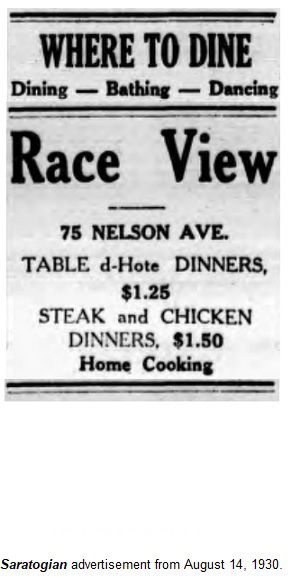
The rebuilt Saratoga Race Course was a huge success when it reopened in 1902, and in subsequent seasons minor changes were made. One modification widened the turns, and Mr. Whitney turned the Second Empire Style house over to Joseph Morrissey, on the condition of it being moved. Mr. Morrissey owned a lot across Nelson Avenue at the corner of Crescent, and his neighbor down the street, Miles Bradley, specialized in that type work. William C. Whitney died unexpectedly in early 1904, before permission could be secured from village officials to move the house. By opening day of the 1906 race season the house, which was rotated 180 degrees during its journey, was in place at its new location. It appears in the City Directory as a boarding establishment for the first time that year, at 75 Nelson Avenue. This project further enhanced the reputation of Miles Bradley as a trustworthy rigger, and he would later be called upon to relocate the 77th Regiment sculpture from its original location on Broadway to the present site inside Congress Park.
Joseph Morrissey continued his employment with Mr. Whitney’s son, Harry Payne Whitney, and had rented the brick house for the season. These were turbulent times in Thoroughbred racing, not only in Saratoga, but across the country. There was a hostile battle between the Jockey Club and those who operated “poolrooms,” which were not billiard halls but off-track wagering facilities. The Jockey Club’s strategy was to suppress all racing information; entries, scratches and changes, prevailing odds and especially results from going over telegraph and telephone wires to the poolrooms. Seemingly each day that August, the Pinkerton detectives representing the Jockey Club would eject poolroom operatives from the track, forcing them to develop novel schemes to acquire the sought-after information. Mr. Morrissey’s boarding house had been leased to those providing communication to the poolrooms, who used the upper stories and roof to peer across Nelson Avenue into the racing grounds. The Pinkertons stretched a broad canvas between two tall poles erected alongside the mile chute. Their grafter foes next erected a pole beside the Morrissey boarding house, with a man at the top. The Pinkerton tarpaulins grew in size, forcing a new pole in response that was said to resemble a tall ship mast, complete with crow’s nest. Conjecture was that an operative on the track infield was using a British Naval device known as a heliograph to flash information to the elevated observer, who then conveyed this to a network of poolrooms via telephone. The men on the pole provided much amusement and distraction to those in the grandstand between races. The Saratoga Association appealed to Joe Morrissey with an inducement of $500, and purchased the exclusive right, privilege and authority to disconnect both telegraph and telephone wires from his house for five years.
Joseph Morrissey continued to lease the house at 75 Nelson Ave to others, who ran it for boarding and occasionally as a restaurant, until 1919 when he sold to the Dingman Family. While under the management of a lessee, issues arose. In the early morning hours of August 15, 1920 Deputy Attorney General Wyman S. Bascom, without the knowledge of the Saratoga Springs Police, led a raid at 75 Nelson Avenue where he found an illegal bar, roulette wheels and a faro bank in operation. The Dingmans sold the property in 1928 to Mary Malone. Originally from County Cork, Ireland she operated a boarding and restaurant facility under her new name for the operation, Race View. Mary Malone and her heirs operated this facility, catering to summer guests for many decades, and the handsome brick structure is a familiar sight to many. If only those walls could speak!